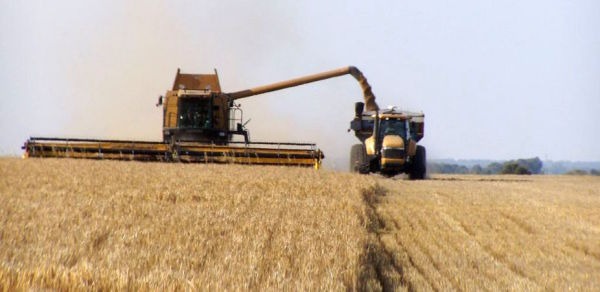Most people understand the idea of a supply chain so that, for example, to make a car you need many thousands of different car components for assembly at the factory. If any of those components are no longer available, there is trouble, and if it’s a major one then you can’t make the car.
The same is true of any typical agricultural crop in Australia. The paddock is where the product is assembled but to make it, many thousands of components are required.
The supply chain of components includes the thousands of microbial and invertebrate species in the soil that make it both stable and fertile. Other components are the crop pollinators, usually insects.
The hundreds of thousands of species of soil organisms and pollinators are farm assets and are generally taken for granted as they are assumed to come free.
But some economists now question this and identify them as part of the natural capital of the system. Even so, they are only infrequently incorporated into economic models, sometimes because little is known about their functions, but more often because economists are simply unaware of them.
Cambridge University’s economist Partha Dasgupta recently referred to this issue among agricultural economists saying “[…] a whole class of assets is missing from their data set”.
Counting all the costs
Imagine the supply chain for a car assembly plant where the costs of the components were unknown. Suppose also there was no knowledge of where the components came from, how they were made and whether or not the supply was in any way threatened. This is the situation for the crop supply chain.
This is a huge issue generally as the global human population is now thought to be trending towards 11-billion by the end of this century, an issue for Australia in particular as the government asserts that we will be the food bowl for Asia.
Let’s check on two questions: What is the condition of the crop supply chain and what does it cost?
Fortunately, thanks to soil and biodiversity science, the condition of the crop supply chain is slowly being revealed. A growing number of studies show that modern intensive agriculture reduces the abundance and diversity of many crucial soil organisms and this causes a decline in soil fertility. This is a very worrying trend.
Mining the soil
In the case of two crucial components of soil fertility – nitrogen and phosphorus – the solution to this decline has been regarded as straight forward.
The activities of the missing soil microbes are replaced by industrially made fertilisers. We effectively mine the soil for nutrients, replace them industrially, and ignore the biological assets that would make the process sustainable.
But the process is so disruptive and wasteful that, astonishingly, nitrogen is now one of the world’s worst pollutants.
The situation with phosphorus is even more acute because of the skyrocketing cost of phosphorus fertiliser and the growing shortages in supply. It is ironic but heartening that one solution to this now being pursued is to explore the soil organisms that naturally process phosphorus, identify them, grow them and then deploy them back into the soil.
Perhaps the costs of fertiliser manufacture, pollution clean-up and the restoration of soil fertility, which run into many billions of dollars worldwide annually, provide some idea of the dollar value – the asset value – of soil organisms.
It is currently assumed that supply chain components (the species) are adequately accounted for by conventional asset classes such as the rather vague “farmland”, that lump them together with many other farm attributes.
But, as we come to understand the practical economic values of individual groups of species that provide essential and specific functions (such as nitrogen and phosphorus processing, or pollination) it is reasonable to ask if they should be valued individually as the costs of their replacement, resulting from intensive agricultural methods, skyrocket.
Part of the supply chain?
Are these fantastically valuable species merely “externalities” as economists usually treat them or, as in automobile manufacture, should their values be assessed individually – as in any supply chain?
Complicating these questions is the fact that we know very little about the extent of serious conservation issues such as the possibility that individual supply components may be threatened with extinction, either locally or globally, but scientists are worried about it.
Most people reckon that microbes don’t go extinct, but the studies I’ve already referred to show that they may decline or even disappear locally or regionally. If that locality is a farm then the asset has effectively gone extinct.
The story of crop pollinators is in many ways similar as the key asset, the honeybee, is in sharp and commercially disastrous decline in many countries.
It is salutary that wild bees and flies that perform well as pollinators are now being assessed as farm assets. Part of their value, quite aside from the food they generate, can be gauged by the costs of increasing their abundance and diversity around crops through local habitat management.
Fortunately there are a few farmers both in Australia and overseas who have become acutely aware of their soil and pollinator assets and are benefiting from greater soil stability and fertility as a result. This may stimulate more economists, farmers and scientists to get to grips with the farming supply chain.
![]() Andrew Beattie is currently an Emeritus Professor at Macquarie University.
Andrew Beattie is currently an Emeritus Professor at Macquarie University.
This article was originally published on The Conversation.
Read the original article.
MAHB-UTS Blogs are a joint venture between the University of Technology Sydney and the Millennium Alliance for Humanity and the Biosphere. Questions should be directed to joan@mahbonline.org
MAHB Blog: https://mahb.stanford.edu/blog/supply-chain-farming/
The views and opinions expressed through the MAHB Website are those of the contributing authors and do not necessarily reflect an official position of the MAHB. The MAHB aims to share a range of perspectives and welcomes the discussions that they prompt.
